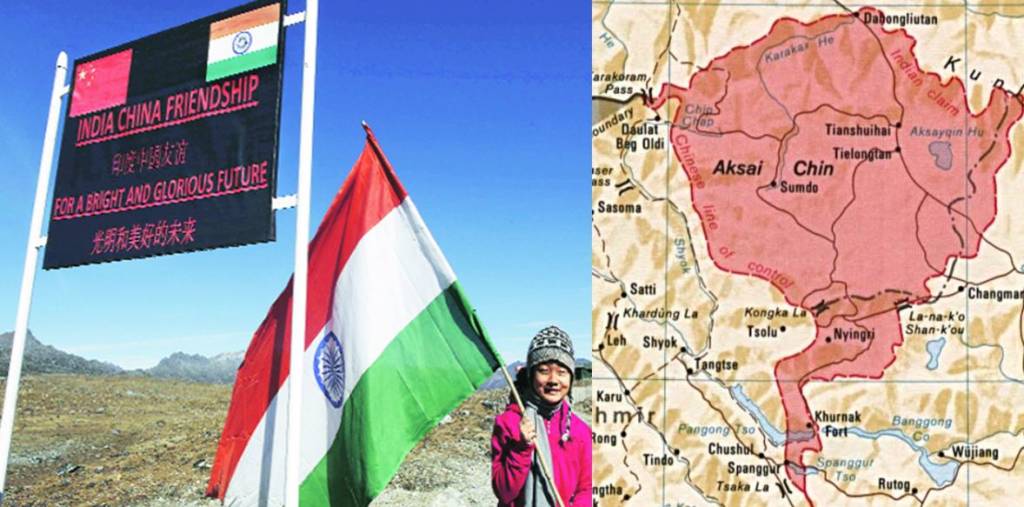The border disputes between India and China have culminated in military tensions and loss of lives for the first time since 1975. The flashpoint of hostilities and soaring tensions is, of course, the Galwan Valley region. But the real point of dispute is not Galwan Valley, but it is Aksai Chin- a misnomer used to refer to China occupied Ladakh.
The Galwan Valley area lies just East of the Siachen glacier and this is the only point of access for New Delhi into the Ladakhi territory occupied by China. Beijing’s suspicions are fuelled by India’s increasing assertiveness about taking back occupied territories. It is particularly concerned about a bridge that India is building over the Galwan nallah. India plans to connect the strategically crucial Shyok-Daulat Beg Oldi road with border posts.
China thinks that it can push back India because it is still used to the ways of the past Indian governments, who have followed a rather soft ‘Aksai Chin’ policy. The fact that India calls Aksai Chin- ‘Aksai Chin’ itself narrates a story of cowardice and appeasement on the part of the political leadership in India.
Aksai Chin roughly translates into “Chin’s desert of white stones”, and it is beyond comprehension why the Indian State should use a term that blatantly suggests Chinese historicity over the region.
It is well known that the occupied territory is actually a part of India’s Union Territory of Ladakh, yet successive regimes have chosen to use the name appropriated by China. According to Ladakh MP Jamyang Tsering Namgyal, “Since 1962, China has cheated India not once or twice but a hundred times. In the 1962 war, they took 37,244 sq km area from us what we know today as Aksai China. I feel strange even to hear the term Aksai Chin. It is not Aksai Chin, it is China-occupied Indian territory.”
He added, “It is China-occupied Ladakh. Our claim on it should always remain. Many people question whether it is possible to take it back. I don’t consider it easy. But I don’t consider it impossible either. After the sacrifice of our soldiers, I am starting to think the time has come to take Aksai Chin back.”
In fact, to be precise, China administers the so-called ‘Aksai Chin’ as a part of the Hotan county in the Hotan prefecture of the Xinjiang Uyghur Autonomous Region.
The Xinjiang Uyghur Autonomous Region however is itself an occupied Chinese territory- much like Tibet. Just like the political leadership did not protest against Chinese occupation of Tibet, it did not even speak against Chinese occupation of Xinjiang.
Xinjiang was briefly declared as an independent East Turkestan State but was soon occupied by the Communist regime of China. By not bringing up this matter, New Delhi allowed Beijing to stake claim on Aksai Chin through Xinjiang.
In fact, Xinjiang is historically a part of the Indian culture, and the region used Sanskrit and Prakrit languages. ‘Aksai Chin’ is a misnomer applied by China, and the real name of the region is ‘Gosthana’ (place of cows). In fact, Ladakhis and Tibetans have historically called it ‘Gosthana’ and not ‘Aksai Chin’.
It is true that Xinjiang was historically a part of the Indian cultural region. The region used Sanskrit and Prakrits.
By Chinese logic of claiming any land that was associated with China or Tibet in remote past, Xinjiang itself should be part of India!https://t.co/ZssYBteX5V
— Subhash Kak ☀️ (@subhash_kak) June 18, 2020
Aksai Chin is a relatively recent Chinese sponsored Uighur name.
Ladakhis & Tibetans called it by the Sanskrit name "Gosthana"(=place of the cows).
Han Chinese have no history or presence in the region. They are just recent occupiers
Use original name & show them their place
— True Indology (@TIinExile) June 17, 2020
The Indian political establishment never used the correct names- ‘Gosthana’/ China occupied Ladakh. What’s in a name, you may ask. Well, a lot when you are handling border disputes with China because Chinese logic is simple and hawkish. Beijing claims any land that was historically a part of China or Tibet.
Not just with India, but in all its border disputes, China claims territories of other countries on the basis of historical grounds. Sometimes these “historical grounds” are rooted in distant past so much so that China has been claiming territories on the basis of fourteenth-century Chinese dynasties.
By allowing China to use a wrong nomenclature, the past governments have allowed China to strengthen its claims on the region, so much so, that the Chinese Foreign Ministry is now claiming sovereignty over the entire Galwan Valley region in a bid to strengthen its position in what it calls Aksai Chin.
New Delhi had a soft China policy, unlike the policy that it pursued against Pakistan on Pakistan occupied Kashmir. Due to ideological reasons, the successive governments did not want to offend China. When China started occupying Indian territory in Ladakh before 1962, Nehru said, “In those barren land and mountains of Ladakh and Arunachal, not even a blade of grass grows, why Parliament is wasting time.”
His successors avoided building solid road infrastructure in the region out of the defeatist mentality didn’t want to give Chinese troops an easy path in case of another 1962 war-like event. Things changed only with Prime Minister Modi who has been building robust road in infrastructure along the effective Sino-India border.
India needs to replicate the ‘PoK’ policy in ‘occupied Ladakh’ as well. India must use the correct terminology that it also uses in the case of Kashmir, and the Indian Parliament must consider passing a resolution in case of China similar to the one in 1994 that stated, “Pakistan must vacate the areas of the Indian state of J&K, which they have occupied through aggression.”
If New Delhi wants to assert its inalienable claims in the occupied areas of Ladakh, it will have to completely shed the defeatist mentality of the past regimes.
